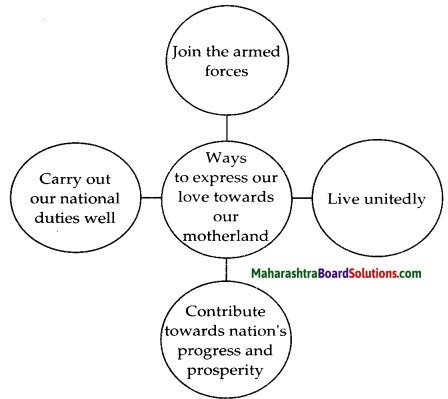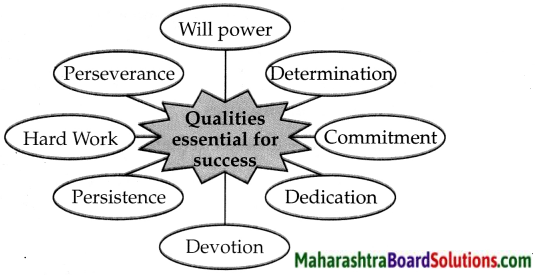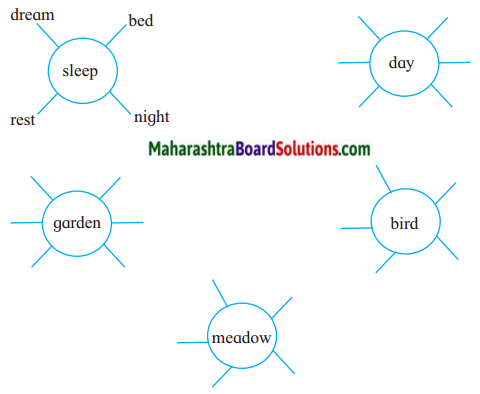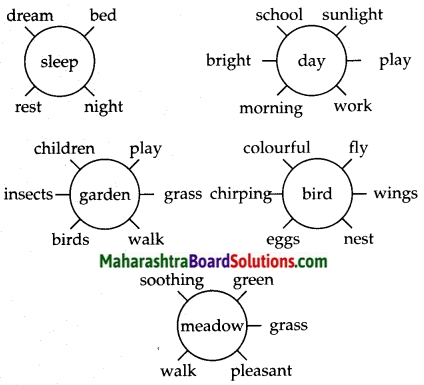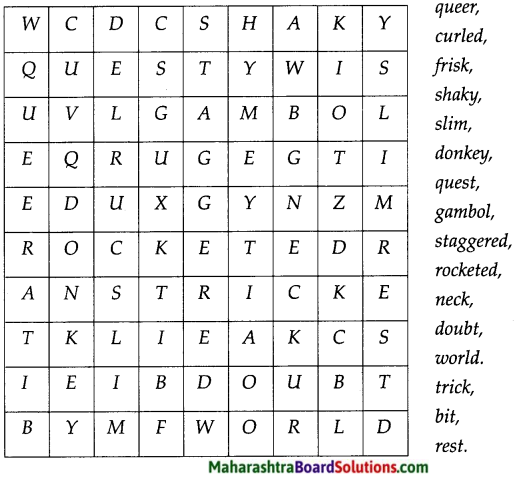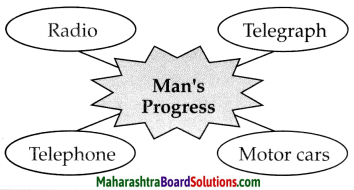Balbharti Maharashtra State Board Class 6 English Solutions Chapter 1.3 Autobiography of a Great Indian Bustard Notes, Textbook Exercise Important Questions and Answers.
Std 6 English Lesson 1.3 Autobiography of a Great Indian Bustard Question Answer Maharashtra Board
Class 6 English Chapter 1.3 Autobiography of a Great Indian Bustard Textbook Questions and Answers
1. Read the passage aloud.
World Heritage English Workshop Question 1.
Read the passage aloud.
2. You are going to meet a Great Indian Bustard very soon. Prepare at least 10 questions to interview him.
World Heritage Question And Answer 10th Class Question 1.
You are going to meet a Great Indian Bustard very soon. Prepare at least 10 questions to interview him.
Answer:
Hello! It is nice to meet you! Please answer a few questions:
- What can you tell us about yourself?
- Where are you and your friends found in India?
- When are you the most happiest?
- Why are your numbers on a decline across the globe?
- Which are the organisations which are supporting you in your struggle for survival?
- How can the government play a role to help birds and animals on the verge of extinction?
- Whose initiatives have led to increased awareness about the plight of the Great Indian Bustard?
- How can media help you in creating awareness about the problems faced by you?
- What would you like the children to do to support you in order to survive?
- Do you have any message for human beings?
![]()
3. Play the roles of an interviewer and a Great Indian Bustard and write the interview.
World Heritage Class 10 Question 1.
Play the roles of an interviewer and a Great Indian Bustard and write the interview.
Answer:
(Students to attempt)
4. Write u letter to your friend about the Great Indian Bustard. You may use the following points:
Why we need to protect the bird.
What you plan to do to help the bird.
World Heritage 10th Class Lesson Question 1.
Write u letter to your friend about the Great Indian Bustard. You may use the following points:
Why we need to protect the bird.
What you plan to do to help the bird.
Answer:
A/18 Deep Mahal,
Sahar Road,
Vile Parle (E),
Mumbai – 400 057,
15th August, 2016.
Dear Rajani,
Hi! Hope this letter finds you in good health and happiness. I am writing this . letter to express my concern about the fact that only the last 200 of the Great Indian Bustards are left in this world.
The animals, birds, insects, trees, rivers, seas and other elements of nature including man are all the part of a link which binds us together, and which keeps us going. It is high time we protect the Great Indian Bustard and other species which are on the verge of extinction.
How right are the words, “Let’s preserve nature, if not for anything else, For the beauty and strength it inspires!”
We can protect the birds by creating awareness through our school magazine. We can write letters to the government officials too. We can discuss this issue with the elders. We can ask our teacher to take us to sanctuaries to have a better understanding of the life of the Great Indian Bustard.
Let us remember: ‘The future lies in our hands. Let us conserve, preserve and protect all the elements of nature.’
Please think about the issue I shared with you.
Yours lovingly,
XYZ
![]()
5. Form pairs and decide whether the following statements are those of a Great Indian Bustard or not.
World Heritage Question And Answer Question 1.
Form pairs and decide whether the following statements are those of a Great Indian Bustard or not.
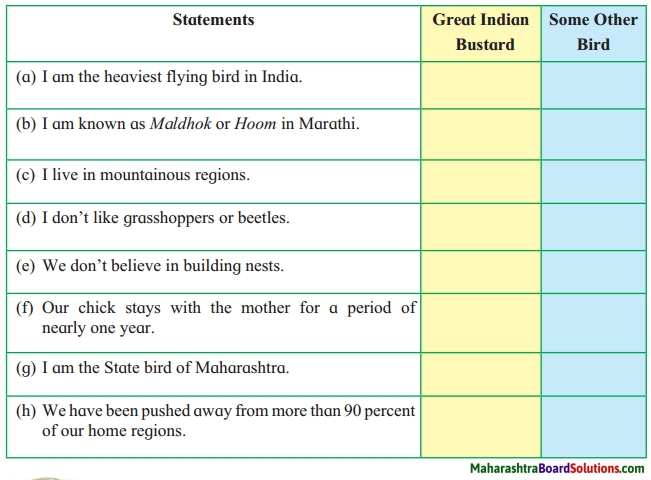
Answer:
| Statements | Great Indian Bustard | Some Other Bird |
| a. I am the heaviest flying bird in India. | ✓ | |
| b. I am known as Maldhok or Hoom in Marathi. | ✓ | |
| c. I live in mountainous regions. | ✓ | |
| d. I don’t like grasshoppers or beetles. | ✓ | |
| e. We don’t believe in building nests. | ✓ | |
| f. Our chick stays with the mother for a period of nearly one year. | ✓ | |
| g. I am the State Bird of Maharashtra. | ✓ | |
| h. We have been pushed away from more than 90 per cent of our home regions. | ✓ |
![]()
6. With the help of the internet and other sources, obtain more information about the critically endangered birds and animals in India. Find the names of their sanctuaries.
Some critically endangered birds and animals in India:
‘CR’ or critically endangered birds or animals are those that are likely to become extinct in the wild. We may never see them again.
- Forest Owlet
- Indian Vulture
- Siberian Crane
- Deoluli Minnow (fish)
- Asiatic Cheetah
- Himalayan Wolf
- Amboli Toad
![]()
7. Prepare a poster on the need for the conservation of the Great Indian Bustard.
World Heritage English Workshop 10th Standard Question 1.
Maharashtra Board Class 6 English Solutions Chapter 1.3 Autobiography of a Great Indian Bustard
Answer:

8. Write a short autobiography of any bird or animal of your choice.
English Workshop Of World Heritage Question 1.
Write a short autobiography of any bird or animal of your choice.
Answer:
Hello friends! I reside in a dense jungle. I love rains and I express my joy by dancing in the rain. People say watching me dance is indeed a beautiful sight. Yes, I am a peacock. I long to fly in the high blue sky like the pigeon. I wish I could fly above the clouds and beyond. Alas! It is not possible.
But I count my blessings. My beauty and the fact that I am the National Bird of India gives me reasons to rejoice and celebrate. Next time you see a graceful bird with a bright shining tail, dancing to its heart’s content in the rainy seasons, you can be rest assured, it’s me.
I have a humble request. Please preserve and protect us. Many of us – my fellow beings are on the verge of extinction. Please save us else we will soon become a part of history.
Remember: Harmony between man and wild life is the only way to solve all the problems faced by the world.
Come, together let us co-exist.
9. Make a list of the channels available on your TV under the following categories:
News, entertainment, sports, movies, music, etc.
Which are the channels on which you can watch programmes on animals, wildlife, conservation of environment, etc.?
![]()
10. Ask your parents to show you TV programmes on animals, wildlife and conservation of environment on channels like the following:
DD National, National Geographic, Discovery and Animal Planet.
11. You have won a prize to visit a wildlife sanctuary or National Park in Africa or Australia. Choose a location, read about it. Imagine that you are visiting it and write a letter to your friend about it.
12. Language Study: Identify the following from the list given in the box below :
4 nouns, 4 verbs, 4 adjectives, 4 adverbs, 4 pronouns.
Question 1.
Identify the following from the list given in the box below :

Answer:
| Nouns | Verbs | Adjectives | Adverbs | Pronouns |
| 1. bird | 1. gather | 1. wonderful | 1. directly | 1. we |
| 2. friends | 2. helps | 2. healthy | 2. together | 2. I |
| 3. humans | 3. protect | 3. happy | 3. away | 3. you |
| 4. grasslands | 4. arrive | 4. afraid | 4. slowly | 4. us |
Class 6 English Chapter 1.3 Autobiography of a Great Indian Bustard Additional Important Questions and Answers
Answer in one sentence.
4.3 World Heritage Question 1.
Which is the heaviest flying bird in India?
Answer:
The Great Indian Bustard is the heaviest flying bird in India.
![]()
World Heritage 10th Class Lesson Workshop Question 2.
How is the female Indian Bustard different from the male one?
Answer:
The female Indian Bustards are smaller and slimmer than their male counterparts, and their neck is not white.
10th Class World Heritage English Workshop Question 3.
Where do the Great Indian Bustards live?
Answer:
The Great Indian Bustards live on grasslands and deserts.
Question 4.
Name any two things which are favourite food items of a Great Indian Bustards.
Answer:
Grasshoppers and beetles.
Question 5.
Rains usher happiness into the lives of the Great Indian Bustards. Pick out proof from the lesson for this statement.
Answer:
“I dance in joy with puffed feathers and cocked up tail and dropped down wings.”
![]()
Question 6.
Who are the enemies of the Great Indian Bustard’s eggs and chicks?
Answer:
Monitor lizards, foxes, dogs, pigs, snakes and eagles are the enemies of the Great Indian Bustard’s eggs and chicks.
Question 7.
What is the difference between the young ones of other birds and the Great Indian Bustards?
Answer:
The difference between the young ones of other birds and the young ones of Great Indian Bustards is that unlike the young ones of other birds which soon fly away from the nest, the Great Indian Bustard’s mother and chick stay together for nearly a year.
Reading Skills, Vocabulary and Grammar
Read the following extract and complete the activities that follow.
Question 1.
Complete the list of things we can do to extend our love and support to help the Great Indian Bustard survive.
Answer:
- Write letters to our leaders and make appeals.
- Make drawings and submit it to your teacher.
- Discuss with your parents.
- Visit a sanctuary.
![]()
Question 2.
Which environmental problem is highlighted in the extract?
Answer:
The decline of the population of the Great Indian Bustard, driving them to the verge of extinction is highlighted in the passage.
Question 3.
Who suggested that the Great Indian Bustard should be given the status of the ‘National Bird?
Answer:
Dr. Salim Ali, a friend of Great Indian Bustards suggested that the Great Indian Bustard should be given the status of the ‘National Bird’.
Question 4.
What is the consequence of the growing population of man on the Great Indian Bustard?
Answer:
The growing population of man has pushed the Great Indian Bustard from more than 90 per cent of their home regions.
Question 5.
Two causes which has led to the decline in the number of the Great Indian Bustard.
Answer:
Hunting, Electric power-line
![]()
Question 6.
We used to live in all parts of India. (State the word class of the underlined part.)
Answer:
all – adjective
Question 7.
We are losing our homes. (Add a question tag.)
Answer:
We are losing our homes, aren’t we?
Question 8.
We need your support and love in order to survive. (Use not only … but also.)
Answer:
We need not only your support but also love in order to survive.
Question 9.
Give the verb forms of:
Answer:
population: populate electric: electrify/electrocute
![]()
Question 10.
Why should we save animals from extinction?
Answer:
Animals are also an important element of the food chain. Many species of animals have become extinct. The animals are invaluable. Our existence depends on them, so to stop the links of food chains from breaking, we should save the animals from extinction.
Language Study
Do as directed.
Question 1.
I have got a long white neck, brown wings, tall yellow legs and a black cap on my head.
Fill in the chart with Nouns and Adjectives.
Answer:
| Nouns | Adjectives |
| necks | long |
| wings | white |
| legs | brown |
| cap | tall |
| head | yellow |
| black |
![]()
Question 2.
Mrs. Bustard is smaller and slimmer than I am. (Pick out the adjectives and state the degree of comparison used.)
Answer:
Adjective: Smaller
Slimmer: Degree of comparison: Comparative
Question 3.
That’s a very healthy habit! (Pick out the adverb.)
Answer:
Adverb: very
Question 4.
It helps me to impress my soulmate. (Rewrite the sentence using the underlined word as noun.)
Answer:
It helps me create an impression on my soulmate.
Question 5.
I dance in joy. (Make it exclamatory.)
Answer:
How I dance in joy!
Question 6.
The egg looks like a stone. (Pick out the articles.)
Answer:
Articles: The, a
![]()
Question 7.
We need your support and love in order to survive. (Pick out the noun and state their kind.)
Answer:
support and love: Abstract Noun
Question 8.
You can discuss this with your parents. (Pick out the modal and state its function.)
Answer:
can: possibility
Question 9.
Come to see us at a sanctuary. (Pick out the preposition.)
Answer:
at: preposition
Question 10.
You will only see us in pictures. (Pick out the adverb.)
Answer:
only – Adverb
![]()
Word building.
Complete the table:
| Noun | Adjective | Verb |
| impression | impressive | impress |
| health | healthy | heal |
| speciality | special | specialise |
| beauty | beautiful | beautify |
| electricity | electric | electrify/electrocute |
| picture | pictorial | picture |
Do you know?
Penguins arrive in Mumbai Zoo. Three male and four female humboldt penguins have been brought in from Seoul, Korea. They have been kept in the quarantine section of the Veermata Jijabhai Bhosale Zoo. While the penguins need to be kept in a temperature between 4° and 25° Celsius, the temperature in the quarantine is between 16° and 18° Celsius. The humboldt penguins are between one and three years of age and have a life expectancy of around 20-25 years.
Autobiography of a Great Indian Bustard Summary in English
In this lesson, the author acquaints us with the different physical characteristics of the Great Indian Bustard. He also talks about their habitat, their eating habits and other details, apart from providing information about their young ones.
He further elaborates that though it is the State Bird of Rajasthan and despite having ten sanctuaries for their protection, their number is on a decline.
Due to uncontrolled population explosion created by man, the Indian Bustards were being pushed away from more than 90 percent of their home regions.
There are other reasons for their decline in number like hunting, electric shock, loss of habitat etc. With the last 200 of the birds left in the world, the lesson reminds us that the birds need our love and support for their survival. The lesson also enlists various ways in which we can do our part to stop the birds from becoming extinct.
Introduction:
Autobiography is a history of a person’s life as narrated by that person, which could be written or oral. Dr. Pramod Patil has used this method of writing to drive home the plight of the Great Indian Bustards who are on the verge of extinction.
![]()
Glossary:
- impressive (adj) – one which evokes admiration
- grasslands (n) – open area in a region covered with grass
- deserts (n) – a large, dry, barren region
- gulp (v) – swallow quickly
- pouch (n) – a sac-like structure in animals, a pocket-like space (here)
- resonating (y) – producing a loud, deep sound
- swarming (v) – moving in large numbers
- sanctuaries (n) – a reserved area for birds and animals to provide them protection
- power-lines (n) – used for electric power transmission
- predators (n) – animals that hunt, kill and eat other animals
6th Std English Questions And Answers:
- Don’t Give Up! Class 6 Question Answers
- Who’s the Greatest? Class 6 Question Answers
- Autobiography of a Great Indian Bustard Class 6 Question Answers
- Children are Going to School …Class 6 Question Answers
- A Kabaddi Match Class 6 Question Answers
- The Peacock and the Crane Class 6 Question Answers
- Param Vir Chakra: Our Heroes Class 6 Question Answers
